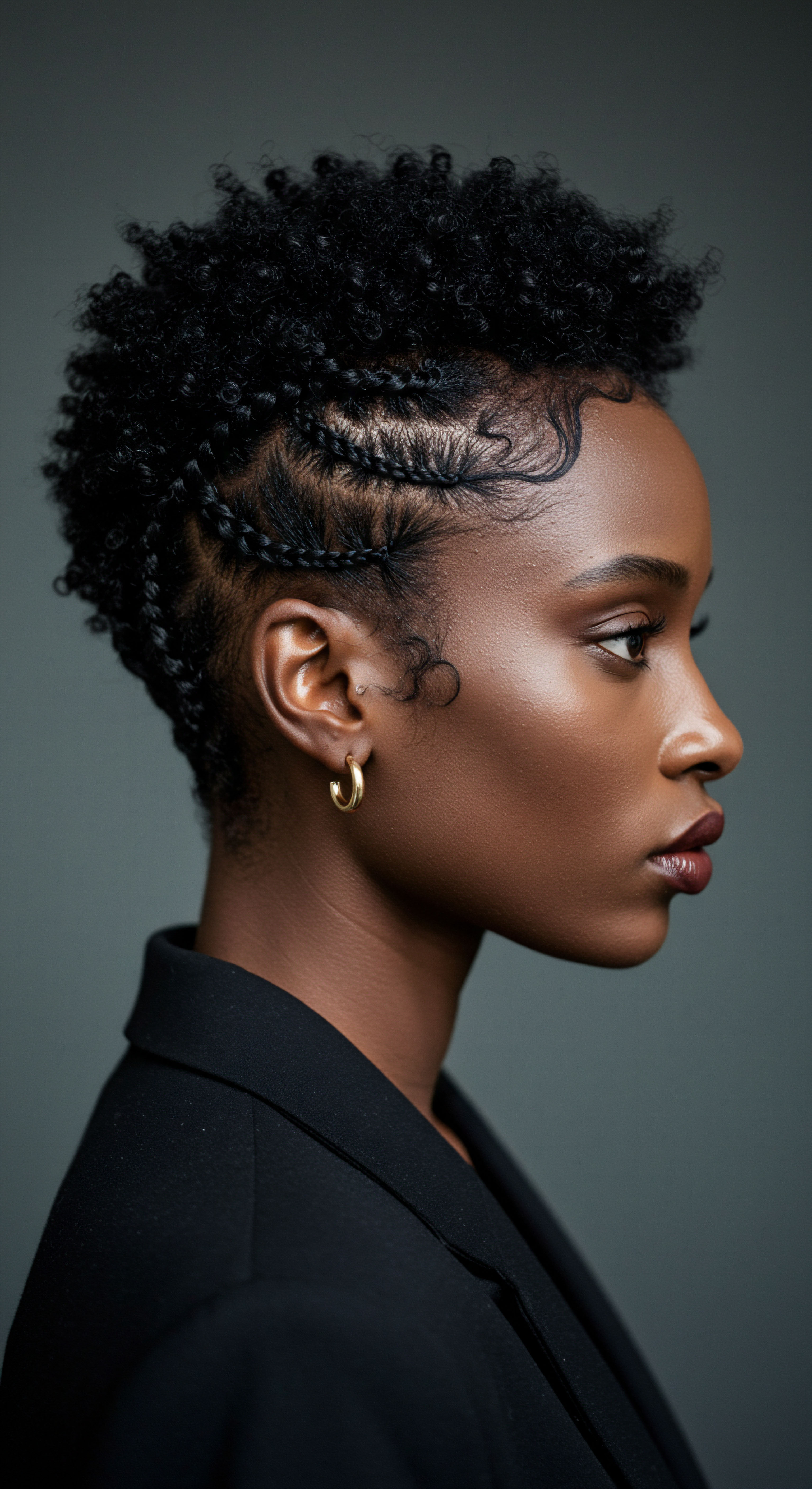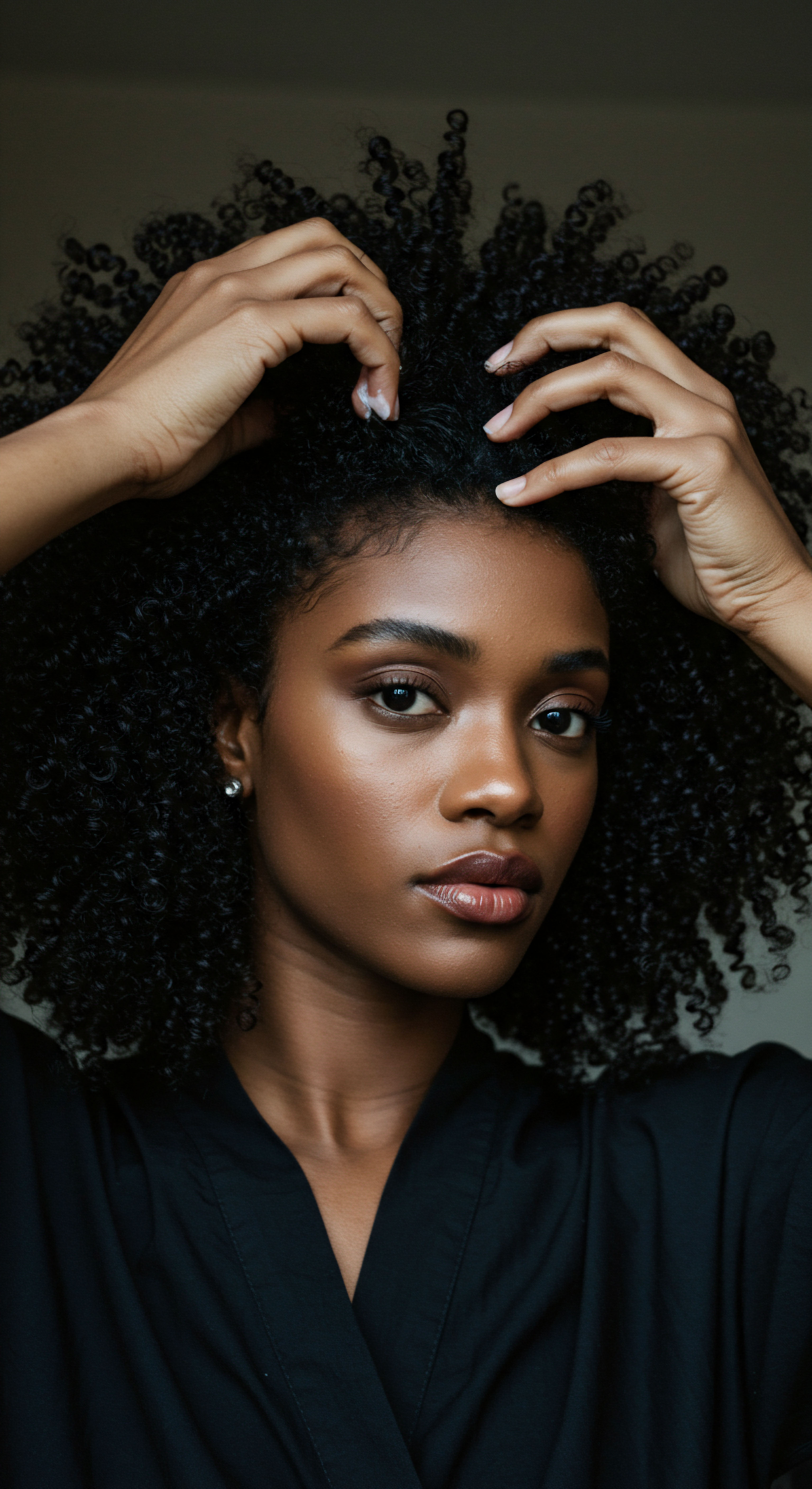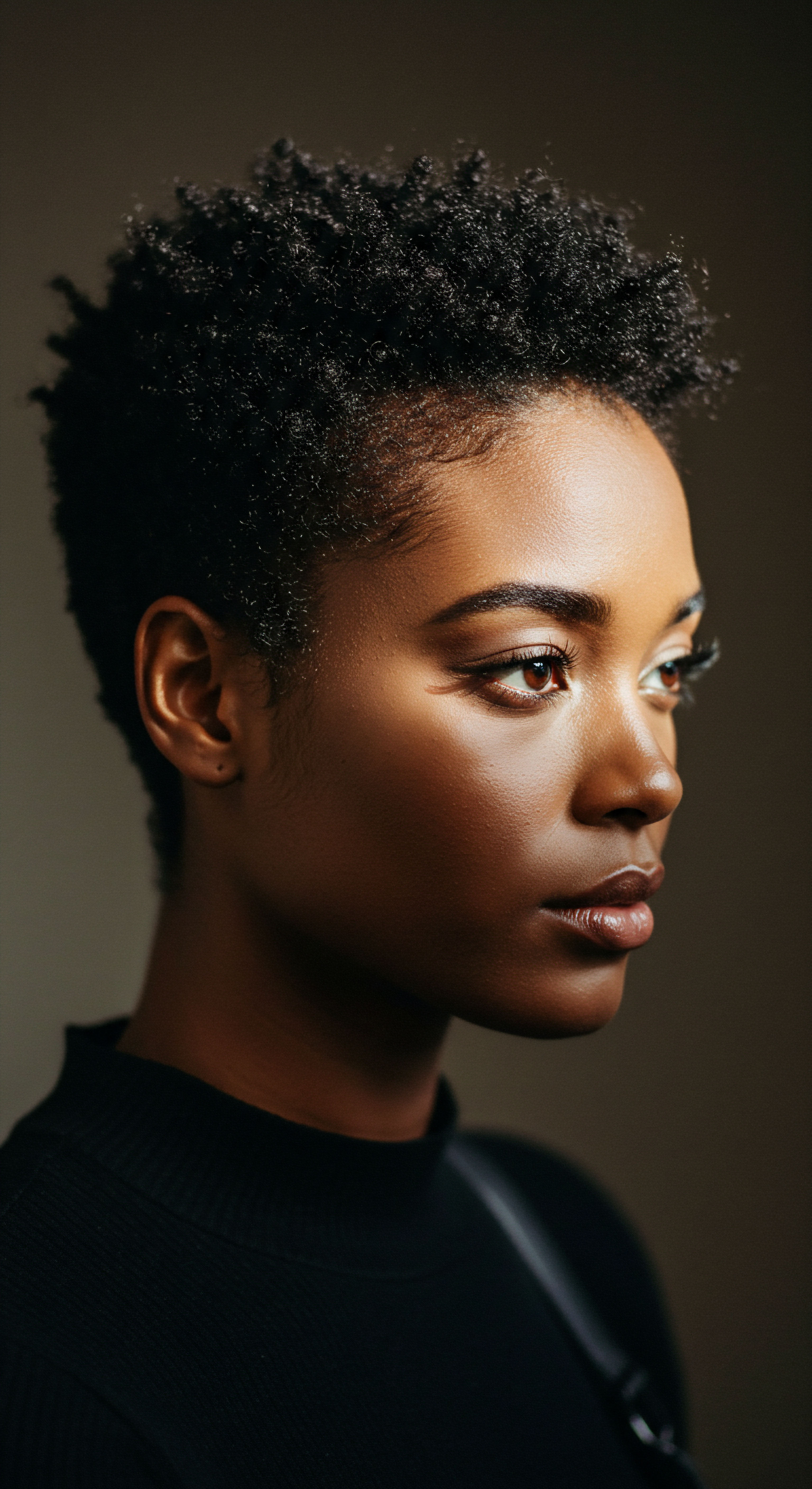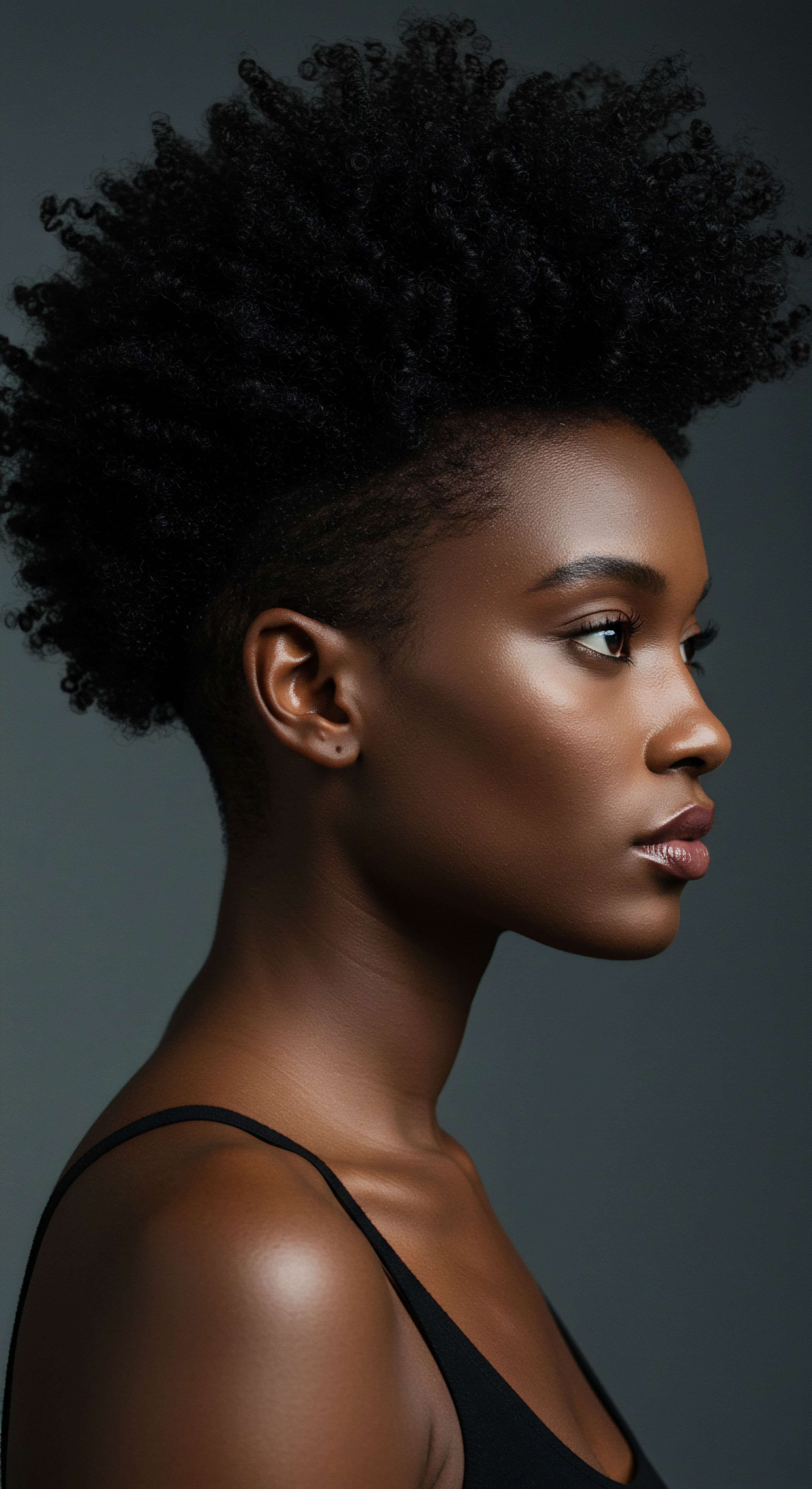
Roots
Consider the quiet moments when the world outside softens, and the day’s demands recede. For those with textured hair, this nightly transition brings with it a subtle yet significant concern ❉ the well-being of our strands as we rest. Each curl, coil, and wave possesses a unique architecture, a delicate blueprint that responds to its environment. Understanding this inherent nature of textured hair is the initial step toward preserving its vitality, especially during the hours of slumber when we are least aware of its vulnerability.
The journey into understanding how sleep caps guard textured hair begins with a deep appreciation for the hair strand itself. Each individual hair is far more complex than it appears, a miniature marvel of biological engineering. At its heart lies the Cortex, providing strength and elasticity. Encasing this core is the Cuticle, a protective outer layer composed of overlapping scales, much like shingles on a roof.
These scales, when healthy and lying flat, reflect light, contributing to shine and smoothness. However, the very structure that gives textured hair its beauty – its characteristic bends and spirals – also renders it more susceptible to certain forms of mechanical stress and moisture loss. The cuticle layers of textured hair often naturally lift more readily than those of straight hair, leading to increased porosity and a greater tendency for moisture to escape.

The Silent Adversary of Friction
As we shift and turn during the night, our hair often rubs against pillowcases. Common bedding materials, particularly cotton, possess a relatively coarse surface. At a microscopic level, these surfaces create friction, a force that can lift, snag, and even chip away at the hair’s delicate cuticle. This constant mechanical agitation over several hours can lead to significant damage.
Imagine the microscopic scales of your hair’s cuticle being repeatedly scraped against a rough surface; over time, this action causes them to become raised, chipped, or even completely removed. This physical abrasion diminishes the hair’s natural protective barrier, leaving the inner cortex exposed and vulnerable.
The inherent architecture of textured hair, with its unique bends and spirals, predisposes it to increased cuticle lifting and moisture loss.
When the cuticle is compromised, the hair becomes more porous. Porosity describes the hair’s ability to absorb and retain moisture. High porosity hair, often a consequence of cuticle damage, readily absorbs water but struggles to hold onto it, leading to dryness, frizz, and a brittle feel. This heightened porosity creates a cycle of vulnerability ❉ damaged cuticles allow moisture to escape, making the hair drier, which in turn makes it more prone to further mechanical damage.

The Moisture Imperative
Textured hair, by its very nature, tends to be drier than straight hair. The coiled structure makes it more challenging for natural scalp oils, known as sebum, to travel down the hair shaft from root to tip. This inherent dryness means moisture retention is not merely a preference; it is a fundamental need for the health and vibrancy of curls and coils. Overnight, this challenge is amplified.
Unprotected hair loses moisture to the surrounding air and absorbent fabrics. A pillowcase made from a material like cotton, for instance, actively wicks away moisture from the hair, leaving it dehydrated by morning. This depletion of essential hydration contributes to dryness, reduces elasticity, and makes the hair more prone to tangling and breakage.
To preserve the integrity of textured hair, mitigating both friction and moisture loss during sleep becomes paramount. This foundational understanding lays the groundwork for appreciating the profound role sleep caps play in daily hair care, moving beyond a simple accessory to a vital tool for long-term hair health.
- Hair Cuticle ❉ The outermost protective layer of the hair, composed of overlapping scales that guard the inner cortex.
- Hair Porosity ❉ The hair’s capacity to absorb and retain moisture, directly influenced by the condition of the cuticle layers.
- Sebum Distribution ❉ The natural oils produced by the scalp, which face challenges traveling down the unique, coiled structure of textured hair.

Ritual
Stepping from the fundamental understanding of textured hair into the realm of its practical care, we find that the night offers a profound opportunity for protection and restoration. The practice of covering one’s hair before sleep is more than a simple habit; it is a mindful ritual, a conscious act of preservation that transforms the vulnerability of night into a period of gentle guardianship. This approach acknowledges the delicate balance required to maintain hair health, moving beyond basic understanding to applied wisdom that yields tangible results.

The Bonnet’s Gentle Embrace
A sleep cap, particularly one crafted from a smooth material like silk or satin, functions as a nightly sanctuary for textured hair. Its primary mechanism of protection revolves around creating a barrier between the hair and abrasive sleep surfaces. When hair glides over a smooth fabric, the friction that leads to cuticle damage is significantly reduced. This minimizes the microscopic trauma that cotton pillowcases can inflict, preserving the hair’s outer layer and, consequently, its strength and shine.
A sleep cap transforms the nightly vulnerability of hair into a period of gentle guardianship.
Beyond friction reduction, sleep caps play a pivotal role in Moisture Retention. Textured hair, as previously noted, is prone to dryness. Products applied to the hair—whether leave-in conditioners, oils, or styling creams—are intended to provide and seal in moisture. An absorbent cotton pillowcase can act like a sponge, drawing these beneficial products and the hair’s natural hydration away.
A silk or satin cap, however, is less absorbent. It allows the moisture and products to remain within the hair, creating a localized, humid environment that helps strands stay hydrated and supple throughout the night. This sustained hydration contributes to improved elasticity, making hair less prone to breakage when manipulated in the morning.

Beyond the Bonnet The Fabric’s Whisper
The choice of material for a sleep cap is not merely a matter of luxury; it is a scientific consideration with direct implications for hair health. Silk and satin are the preferred materials due to their distinct properties. While often used interchangeably in common conversation, they possess nuanced differences.
Silk, a natural protein fiber produced by silkworms, boasts a smooth surface and is inherently less absorbent than cotton. Its protein structure also allows for breathability, preventing excessive heat buildup around the scalp. Satin, on the other hand, refers to a type of weave that creates a glossy, smooth surface. While satin can be made from silk, it is often composed of synthetic fibers like polyester or rayon.
When satin is made from synthetic materials, it still offers a smooth surface that reduces friction, but it may not offer the same breathability or moisture-regulating properties as natural silk. However, for many, synthetic satin provides an accessible and effective alternative for nightly hair protection.
Consider the comparative benefits of different sleep surfaces ❉
| Material Cotton |
| Friction Reduction Low (High Friction) |
| Moisture Retention Low (Absorbent) |
| Breathability Moderate |
| Material Synthetic Satin |
| Friction Reduction High |
| Moisture Retention Moderate |
| Breathability Lower |
| Material Natural Silk |
| Friction Reduction Very High |
| Moisture Retention Very High |
| Breathability High |
| Material Smooth, less absorbent materials like silk and satin are superior for protecting textured hair overnight. |

Preparing Strands for Slumber
The efficacy of a sleep cap is amplified when paired with a thoughtful pre-sleep hair care routine. Preparing your hair for its nightly rest ensures maximum benefit from the protective covering.
This preparatory ritual can include ❉
- Gentle Detangling ❉ Carefully remove any knots or tangles using a wide-tooth comb or your fingers. This prevents further tangling and stress on the hair during sleep, which can lead to breakage.
- Moisture Application ❉ Apply a light leave-in conditioner or a moisturizing cream to your hair. This provides a layer of hydration that the sleep cap then helps to seal in, rather than allowing it to evaporate or be absorbed by bedding.
- Loose Styling ❉ Secure hair in a loose pineapple, a few large braids, or twists. These styles keep the hair contained, minimize movement within the cap, and help maintain curl definition without causing tension on the scalp or hair follicles.
The deliberate choice of a sleep cap and the preceding gentle care transforms nightly rest into an active phase of hair protection, ensuring that each morning greets you with more manageable, hydrated, and resilient strands.

Why Do Sleep Caps Feel So Right?
The comfort and perceived benefit of a sleep cap extend beyond the purely physical. For many, the act of donning a cap before bed becomes a soothing signal, a moment of self-care that transitions from the day’s activity to restorative rest. This psychological element contributes to a holistic sense of well-being, where the gentle enclosure of the cap becomes synonymous with care and protection.
The smooth fabric against the scalp can be inherently comforting, a small luxury that makes the nightly ritual something to anticipate rather than a chore. This feeling of being cared for, even by an inanimate object, adds a subtle yet significant layer to the overall experience of using a sleep cap, making it a truly integral part of a healthy hair regimen.

Relay
Moving beyond the direct mechanics and daily rituals, a deeper exploration of sleep caps for textured hair reveals a confluence of historical resonance, scientific specificity, and profound personal connection. This is where the story of protection becomes interwoven with broader cultural tapestries and the microscopic realities of hair biology, offering a multi-dimensional understanding of why these seemingly simple coverings hold such significant value.

A Cultural Chronicle Hair Coverings Through Time
The practice of covering hair for protection, modesty, or cultural expression is not new; it stretches back through centuries, particularly within African and African diaspora communities. Head coverings, whether elaborate gele, functional wraps, or simple kerchiefs, have long served as powerful symbols of identity, status, and resilience. During the transatlantic slave trade, enslaved African women often had their heads forcibly shaved, a brutal act designed to strip them of their cultural heritage and identity.
Yet, even in the face of such oppression, the practice of head wrapping persisted, transforming into a subtle act of resistance and a means of preserving dignity. Some accounts even describe enslaved individuals braiding rice and seeds into their hair, concealed by wraps, as a means of survival during escape.
The modern sleep cap, while serving a distinct practical purpose, carries echoes of this rich history. It represents a contemporary continuation of a tradition of intentional hair care and protection, a link to ancestral wisdom that recognized the vulnerability of hair and the importance of its preservation. The act of wearing a sleep cap, therefore, can be seen as a quiet affirmation of heritage, a daily acknowledgment of a lineage of care that spans generations.
The modern sleep cap echoes a long cultural history of intentional hair care and protection.

The Science of Surface Interaction A Microscopic View
The protective capabilities of sleep caps are not merely anecdotal; they are grounded in the measurable principles of tribology, the science of friction, lubrication, and wear. At the heart of the issue lies the coefficient of friction between hair and various surfaces. Hair, particularly textured hair with its undulating structure and naturally raised cuticle scales, is highly susceptible to frictional damage.
A study examining the microscopic effects of textile surfaces on hair demonstrated a compelling correlation between surface roughness and hair cuticle damage. Research by Robbins, et al. published in the Journal of Cosmetic Science in 2017, investigated the friction and breakage of human hair when exposed to various textile surfaces. Their findings indicated that materials with higher coefficients of friction, such as cotton, significantly increased the likelihood of cuticle abrasion and hair breakage compared to smoother surfaces.
Specifically, the study highlighted that the directional friction of hair, due to its overlapping cuticle cells, makes it particularly vulnerable to damage when dragged against rough surfaces. This empirical data provides a scientific basis for the long-observed benefits of smooth sleep surfaces. The difference in friction can be substantial; some studies indicate that a silk pillowcase can create 43% less friction than a cotton counterpart, significantly reducing frizz and breakage.
The damage extends beyond mere friction. Cotton, a hydrophilic material, readily absorbs water. This means that as you sleep, cotton pillowcases actively draw moisture from your hair, contributing to dehydration. Textured hair, already prone to dryness due to the irregular distribution of natural oils, becomes even more parched.
This dryness compromises the hair’s Elasticity, its ability to stretch and return to its original shape without breaking. When hair loses its elasticity, it becomes brittle and more susceptible to mechanical damage, creating a destructive cycle.
| Surface Material Cotton |
| Friction Coefficient High |
| Moisture Absorption High (Hydrophilic) |
| Impact on Cuticle Significant abrasion, lifting, chipping |
| Surface Material Silk |
| Friction Coefficient Low |
| Moisture Absorption Low (Hydrophobic) |
| Impact on Cuticle Minimal abrasion, cuticles remain smooth |
| Surface Material Lower friction and moisture absorption properties of silk contribute to superior hair protection. |

How Do Hormones Influence Hair Health Overnight?
Beyond external factors, the body’s internal rhythms and chemistry play a subtle but significant role in hair health, even during sleep. Hormones, those chemical messengers coursing through our systems, influence everything from hair growth cycles to texture and density. While sleep caps primarily address external stressors, understanding these internal influences deepens our appreciation for holistic hair care.
For example, melatonin, often associated with regulating sleep-wake cycles, has also been shown to have protective effects on hair follicles, potentially extending the Anagen Phase, the active growth period of hair. Adequate, restorative sleep, facilitated by comfortable sleep environments (which a sleep cap can contribute to), supports the body’s natural hormonal balance. Conversely, chronic sleep deprivation can lead to elevated stress hormones like cortisol, which can negatively impact hair growth and contribute to temporary hair thinning or loss.
This interconnectedness underscores that while a sleep cap offers direct physical protection, it also indirectly supports the broader physiological conditions conducive to healthy hair. The act of creating a serene sleep environment, where hair is protected, allows the body to focus on its natural regenerative processes, including those that sustain hair vitality.
- Anagen Phase ❉ The active growth stage of the hair cycle, lasting from two to seven years.
- Catagen Phase ❉ A transitional phase where hair growth ceases, lasting a few weeks.
- Telogen Phase ❉ The resting phase, typically lasting a few months, after which the hair sheds.
The protective action of a sleep cap, therefore, extends beyond simple physical barriers. It contributes to a micro-environment that safeguards moisture, reduces destructive friction, and, in a more subtle yet meaningful way, supports the body’s natural regenerative processes that occur during the quiet hours of rest. This multifaceted approach to nighttime hair care highlights the depth of understanding required to truly nurture textured strands.

Reflection
As the quiet dawn approaches, bringing with it the promise of a new day, the journey of understanding how sleep caps protect textured hair culminates not in a definitive end, but in a broadened perspective. We have moved from the intricate cellular details of the hair strand to the echoes of ancestral practices, from the cold, hard data of friction coefficients to the gentle comfort of a nightly ritual. The sleep cap, once perhaps seen as a mere accessory, reveals itself as a conduit for preserving both the physical integrity of textured hair and a deeper connection to self-care and cultural legacy.
It is a testament to the idea that true well-being arises from an understanding of interconnectedness—the scientific with the spiritual, the practical with the profound. To care for our hair in this way is to honor its unique biology, its rich history, and its enduring place in our personal stories.

References
- An Overview on Hair Porosity. NYSCC, 2020.
- The details of the hair growth cycle. Zantman Clinic.
- Braids, Plaits, Locs ❉ The History of Black Protective Hairstyles. Royaltee Magazine, 2021.
- Satin vs. Silk Pillowcases for Hair ❉ What’s the Difference? Byrdie, 2025.
- Does Sleeping on Only One Side Cause Hair Loss? Esteworld.
- Managing Elasticity and Porosity in Hair. Science-y Hair Blog, 2014.
- Trichology – The Science of Hair – Hair Colour for Hairstylists. BC Open Textbooks.
- The Hair Growth Cycle & The Structure of Hair. Rogaine.
- The History and Symbolism of Hair Wrapping Across the African Diaspora. 2025.
- Satin Vs Silk Pillowcase For Hair ❉ What’s Better? 2024.
- Curls and Straights ❉ The Surprising Ways Hormones Affect Your Hair Shape. Embrace.
- Human hair growth. Wikipedia.
- Understanding Everything About the Hair Growth Cycle. Dr Cinik.
- Is Silk or Satin Better for Hair? TikTok’s Viral Hack vs. Science. Blissy, 2025.
- HEADWRAPS ❉ HISTORY AND EVOLUTION. JD Institute of Fashion Technology, 2021.
- Protective hairstyle. Wikipedia.
- Satin vs Silk Pillowcase ❉ Pros & Cons for Skin, Hair, Sleep. Blissy – New Zealand, 2025.
- Braids, Locs, and Beyond ❉ The Beauty and History of Protective Styles. Sartorial Magazine, 2025.
- Satin or Silk Pillowcases ❉ Which is Better? Soak&Sleep, 2025.
- Understanding Porosity, Elasticity, and Density. Curls ‘n Clouds.
- Hair Texture, Porosity, Density | Hair Biology 101. Absolutely Everything Curly, 2021.
- Nanoscale Friction of Biomimetic Hair Surfaces. bioRxiv, 2022.
- Does Sleep Affect Hair Growth? The Correlation We All Need to Know. 2023.
- Efficient Hair Damage Detection Using SEM Images Based on Convolutional Neural Network. MDPI.
- 8 tips to prevent hair loss while sleeping. Healthshots, 2024.
- The effect of sleep quality on hair regrowth. PNWS-AWWA – Drinking Water Management & Resources for Northwest Professionals, 2025.
- Friction and wear of human hair fibres. Open Research Online, 2016.
- The Art and Science of Trichology ❉ Mastering the Health of Your Tresses. Hilaris Publisher.
- The effect of grooming on the hair cuticle. ResearchGate, 2019.
- All-day hair manageability for textured hair types – A revision of the current anti-frizz technologies and suggestions for the future.
- The Hard Labor That Fuels the Hair Trade. Sapiens.org, 2022.
- Unlocking the Secrets of Trichology for Optimal Hair and Scalp Health. Face the Future, 2025.
- Studies of human hair by friction force microscopy with the hair-model-probe. PubMed.
- Natural Hair Moisture Retention Challenge For Dry Hair. OrganiGrowHairCo, 2024.
- Does Sleep Affect Hair Health? DiStefano Hair Restoration Center, 2025.
- Our Trichologist’s hair washing dos and don’ts. Chāmpo.
- 10 Simple Tricks to Keep Your Hair From Getting Frizzy Overnight. Gisou, 2023.
- Studying the Body in Rastafari Rituals ❉ Spirituality, Embodiment and Ethnographic Knowledge. ResearchGate, 2016.
- How I Preserve My Curl Definition Overnight. NaturallyCurly – Beautycon.com, 2017.
- Expert-Formulated Hair Care for Better Results ❉ Why Trichology Matters. Holistic Hair®, 2024.
- Anthropology of the Night ❉ Cross-Disciplinary Investigations1. The University of Chicago Press ❉ Journals.
- Anthropology of The Night. Scribd.
- Trichology. SlideShare, 2021.
- The Effortless Evening Routine. Septième.
- The Physical Properties of Hair Fibers. OUCI.